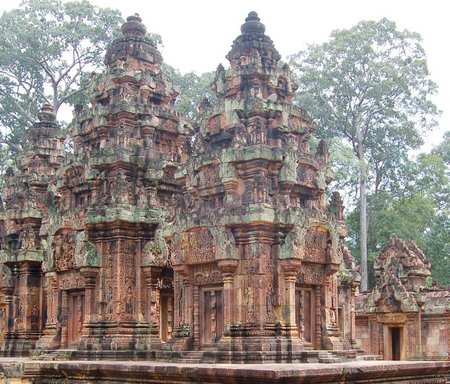Angkor, the forgotten city
|
|
|
Angkor Wat. |
The city of Angkor in Cambodia flourished from the ninth-13th century. For many, it appears both mysterious and sacred. It is indeed a mesmerizing and fascinating area to explore.
Ancient history
The word Angkor was derived from the Sanskrit "nagara," which literally means "city." The Angkorian period began in 802, when the Khmer Hindu monarch Jayavarman II declared himself a universal monarch and god-king. In 1431, Ayutthayan invaders ransacked the Khmer capital, causing its population to flee south to Phnom Penh.
The ruins of Angkor, now a UNESCO World Heritage Site, are located amid forests and farmland to the north of the Great Lake (Tonle Sap) and south of the Kulen Hills, near modern-day Siem Reap. The temples range in scale from nondescript piles of brick rubble scattered through rice fields to the magnificent Angkor Wat, said to be the world's largest single religious monument. In the past 35 years, about 197 of the 1,000 odd temples have been restored and are now open to the public; together they comprise the significance of Khmer architecture.
The main attraction of the Angkorian region, Angkor Wat, was built between 1113 and 1150 by King Suryavarman II. Suryavarman ascended to the throne after prevailing in a battle with a rival prince. After consolidating his political position through military campaigns, diplomacy and a firm domestic administration, Suryavarman launched into the construction of Angkor Wat as his personal temple and mausoleum.
Breaking with the tradition of the Khmer kings and influenced perhaps by the concurrent rise of Vaisnavism in India, he dedicated the temple to Vishnu rather than to Siva. With walls nearly 800 meters long on each side, Angkor Wat grandly portrays Hindu cosmology, with the central towers representing Mount Meru, home of the gods; the outer walls, the mountains enclosing the world; and the moat, the oceans beyond. Suryavarman had the walls of the temple decorated with bas-reliefs, carving virtually every inch of stone, depicting not only scenes from mythology, but also from the life of his own imperial court.
The year 1296 marked the arrival of Chinese diplomat, Zhou Daguan, who is also the author of The Customs of Cambodia, perhaps the last surviving account (approximately 40 pages) that includes detailed observations of Khmer society.
Some of the topics he addresses are those of religion, justice, agriculture, clothing and commerce. Together with inscriptions found on Angkorian steles, temples and other monuments and with the bas-reliefs at Bayon and Angkor Wat, Zhou's journal is an important source of information that interlinks these recordings of everyday life in ancient Angkor.
The end of the Angkorian period is generally set as 1431, although the civilization had already been in decline in the 13th and 14th centuries. During the 15th century, nearly all of Angkor was abandoned, except for Angkor Wat, which remained a Buddhist shrine. Several theories have been suggested to account for the decline and abandonment of Angkor but the closest experts can get to evidence is guesswork.
 0
0 








Go to Forum >>0 Comments